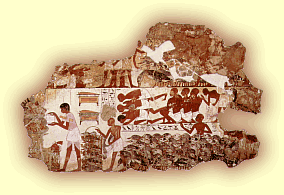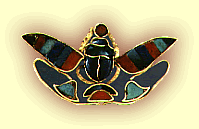
Blue glazed
composition tiles
with a guilded
heiroglyph text,
c.1390 BC |
As miniature pictures, hieroglyphs could
be used as an art form as well as a means of conveying information.
As such they were used on almost all types of Egyptian art, often
woven into the images they accompanied, such as the wall-painting.(top)The
hieroglyphs record the workers' comments (like speech-bubbles
in modern cartoons) as they serve the tomb-owner. The workers
above are told by the man carrying a cane: Sit and don't talk!
Hieroglyphs could also be made of glazed composition, such as
this set of tiles from a palace doorway, (left)which have the
name and titles of Amenhotep III (1391-1353 BC) rendered in gilded
gesso relief. The pectoral below
is also formed from hieroglyphs (scarab, hill and sun) which
write the throne-name of Senwosret II.(below)
|
|



